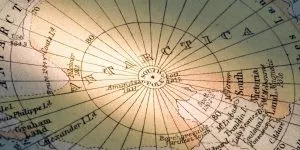We might know the southern-most continent for its ice-covered landscapes, but there are plenty of facts about Antarctica that we might not be aware of. Today, we’ll ask, are there any volcanoes in Antarctica?
Yes, there are 138 volcanoes in Antarctica, ranging in height from 100m to over 4,000m above sea level. They are mostly found in West Antarctica which is one of the densest volcanic regions in the world. However, only 1 of the 138 Antarctic volcanoes, Mount Erebus, is currently active.
Keep reading to find out more about these volcanoes, including the highest volcano on the continent, and what happens when they erupt.
How Many Volcanoes Are There in Antarctica?
There are thought to be 138 volcanoes in Antarctica, although most of these are extinct1 (source: M. van Wyk de Vries, et al., Geological Society Special Publications, Vol. 461, 231-248, 2017). The volcanoes mostly lie hidden under the thick ice sheet of West Antarctica making them sub-glacial volcanoes.
It was only in 2017 that Edinburgh University researchers realized the full extent of Antarctica’s volcanos when they analyzed the landmass underneath the ice which was mapped by ice-penetrating radar in a previous survey called Bedmap2. Prior to the 2017 survey, scientists had only identified 47 of the 138 volcanoes.
The new data suggests that West Antarctica has one volcano per 18,500 km2, rising to one volcano 7,800 km2 along the central ridge. This makes it one of the densest volcano provinces in the world.
Are the Volcanoes in Antarctica Active?
Only 1 of the 138 volcanos on the Antarctic mainland remain active today, this is Mount Erebus (3794m or 12,447ft above sea level) which is located in West Antarctica2 (source: NASA). This volcano continues to erupt regularly to this day.
A second active volcano sits just off the coast of Antarctica in the South Shetland Islands, this is called Deception Island (576m or 1890ft above sea level).
Deception Island is notable as the entire island is the caldera of a volcano, this is the name given to a volcano crater when it has collapsed.
Because some of the sides of the caldera have fallen in, it forms a large horseshoe shape island which makes it the only place in the world where ships can sail directly into the center of an active volcano3 (source: NASA).
What Happens if a Volcano Erupts in Antarctica?
If a sub-glacial volcano erupts in Antarctica, the rising lava would melt the ice above it. This could result in large floods of water known as a jökulhlaup.
Glaciers in Antarctica flow towards the ocean just like a river (known as basal sliding or glacier flow), however, they move so slowly that they appear static when you look at them. This timelapse video will help you understand by showing glacier flow in action.
They slide because freshwater underneath the glacier works like a lubricant, allowing the ice to slowly slide downhill.
But how does this relate to sub-glacial volcano eruptions? Well, a jökulhlaup (large flood of sub-glacial water) from an erupting volcano underneath the ice provides additional “lubricant” to glaciers which could increase the speed at which they flow into the ocean and is likely to contribute to already rising sea levels.
The extent of the damage from such floods would depend on the extent of the eruption and there are many other potential outcomes too, such as the forming of a new surface lake.
A single eruption is unlikely to influence the future of the entire ice sheet4 (source: D. Vaughan, Nature Geoscience, Vol. 1, No. 2, 2008), however, in such a densely volcanic area, widespread eruptions in the region could release enormous volumes of waters which could destabilize the entire ice sheet.
The large weight of the ice in Antarctica helps prevent the pressurized magma chambers from erupting. However, if the ice in Antarctica melts, it could cause some of these volcanoes to erupt again5 (source: The Conversation).
Map of Volcanoes in Antarctica
Here is a map of some of the confirmed volcanoes in Antarctica (does not include the full 138 mentioned earlier). As you can see, they are highly concentrated in West Antarctica:

What is the Highest Volcano in Antarctica?
The volcanoes in Antarctica vary in height from 100m up to more than 4,000m above sea level. The tallest volcano in Antarctica is Mount Sidley which stands at 4,285m 6 (source: D. Gildea, Mountaineering in Antarctica, 2015), earning it a place as part of the volcanic seven summits (the highest volcanoes on each continent).
Mount Sidley is a stratovolcano which means that it has a wide caldera (collapsed crater) that is 5km (3 miles) in diameter. The volcano was first climbed by Bill Atkinson in 1990, a New Zealander working with the US Antarctic Program7(source: D. Gildea, Mountaineering in Antarctica, 2015).
Mount Sidley is part of the Executive Committee Range, which is a range of 5 major volcanoes in Marie Byrd Land, West Antarctica.


![You are currently viewing Are There Volcanoes in Antarctica? [Yes, And Some Are Active!]](https://polarguidebook.com/wp-content/uploads/2022/03/Are-the-volcanoes-in-Antarctica.jpg)
![Read more about the article 7 Antarctica Conspiracy Theories [+ The Truth Behind Them]](https://polarguidebook.com/wp-content/uploads/2022/04/Antarctica-Conspiracy-Theories-300x150.jpg)

![Read more about the article 21 Jokes About Antarctica and the South Pole [One-Liners, Dad Jokes + More]](https://polarguidebook.com/wp-content/uploads/2022/11/Antarctic-jokes-300x200.jpg)